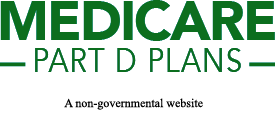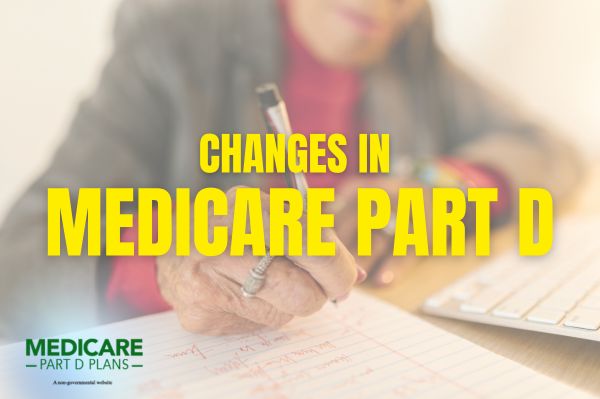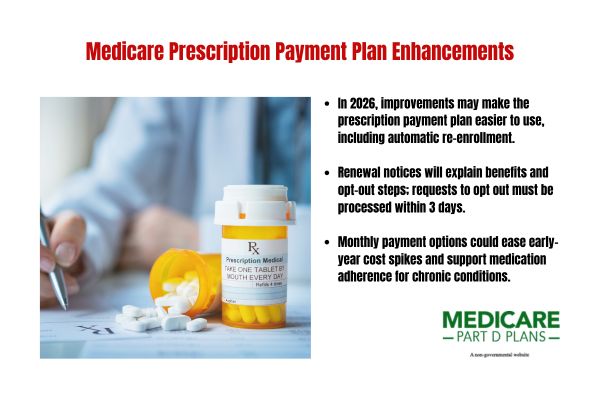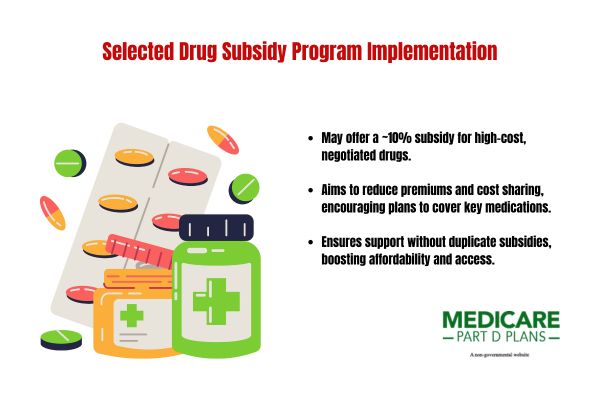Find a Medicare Part D prescription drug plan

Medicare Part D
Prescription Drug Coverage 2026
Medicare Part D Changes in 2026
The potential Medicare Part D changes
Starting January 1,
Whether you’re enrolled in traditional Medicare coverage with a standalone prescription drug plan or Medicare Advantage Plans that may offer integrated drug benefits, understanding these potential changes will likely be crucial for making informed decisions during the upcoming annual open enrollment period. This comprehensive article breaks down everything you should know about the potential
Possible Medicare Part D Updates for 2026
The standard Part D deductible might increase to about $615
Importantly, some plan sponsors might retain flexibility to potentially reduce deductibles or may eliminate them entirely, depending on the plan design. This means beneficiaries should carefully compare Medicare Part D plans during open enrollment, as some may offer lower deductible options that could provide financial savings.
The maximum out-of-pocket spending cap may increase to about $2,100
The Medicare prescription payment plan might begin automatic renewals
Lower cost sharing for all adult vaccines recommended by the advisory committee on immunization practices may also continue
The $35-per-month cost cap for insulin products may also remain in effect with certain benefits. Most covered insulin products under Part d coverage will likely qualify for this cap, and beneficiaries might not need to meet their deductible before accessing these potentially reduced prices. This front-line benefit could potentially help ensure affordability for insulin-dependent Medicare beneficiaries from day one of coverage.
A selected drug subsidy program may also launch on January 1,
2026 Part D Cost Structure Changes
The redesigned
Deductible Phase: Beneficiaries will likely pay up to 100% of drug costs until reaching the $615 annual deductible, unless their prescription drug plan offers a lower deductible. This phase likely affects certain upfront prescription drug costs for the year’s initial prescriptions, likely making plan comparison crucial for those who fill prescriptions early in the calendar year.
Initial Coverage Phase: After meeting the deductible, beneficiaries might pay an approximate uniform 25% coinsurance rate for certain covered prescription drugs until total out-of-pocket costs reach the $2,100 threshold. The remaining 75% will likely be divided among the plan sponsor, drug manufacturers, and—for selected drugs—the federal government through the new subsidy program. This potential cost sharing amount may apply consistently whether coverage comes through standalone prescription drug plans or Medicare Advantage Plan.
Catastrophic Coverage Phase: Once the out-of-pocket limit has been reached, further covered prescription costs may drop to zero for the enrollee for the remainder of the year. Costs beyond this point may be shared among plan sponsors (60%), manufacturers (20% for applicable drugs), and Medicaid services (20-40% depending on medication type), but Medicare beneficiaries may be protected from additional prescription drug expenses.
This three-phase structure might eliminate the previous coverage gap (often called the “donut hole”) and could potentially create predictable cost sharing that may align with financial support with those facing heavier prescription drug expenses.
Medicare Prescription Payment Plan Enhancements
The prescription payment plan might receive significant operational improvements
Plan sponsors must also send renewal notices to all eligible Part D enrollees following the annual election period, clearly explaining the potential program benefits and opt-out procedures. Any beneficiary wishing to discontinue participation must submit a formal opt-out request, which plan sponsors are required to process within three calendar days of receipt.
This payment plan will likely address the potential financial challenges beneficiaries might face when required to pay their deductible or cost sharing early in the calendar year. By possibly spreading these costs into equal monthly payments, the program might help prevent prescription non adherence due to cost spikes and potentially reduce administrative burden for both beneficiaries and plan sponsors.
This potential prescription payment plan might particularly benefit those with chronic conditions requiring expensive medications, as it could provide predictable monthly budgeting rather than unpredictable cost surges when prescriptions are filled.
Insulin and Vaccine Coverage Improvements
The approximate $35 monthly insulin cap may receive additional codification and enhancement
Critically, the Part D deductible might be waived for certain insulin products, meaning the $35 cap might be available upon plan enrollment without requiring beneficiaries to first meet their annual deductible. This could potentially represent a significant improvement in access, as insulin-dependent Medicare beneficiaries may access affordable insulin from their first prescription fill of the calendar year.
The deductible waiver for ACIP-recommended adult vaccines may potentially ensure reduced cost sharing continues, likely maintaining broad vaccine access under certain Medicare prescription drug plans. This potential coverage might include annual influenza vaccines, COVID-19 vaccines, and other immunizations.
The vaccine coverage list will likely be updated annually to reflect the most current ACIP guidance, possibly ensuring responsive, evidence-based preventive care. This approach may help support both individual health outcomes and broader public health objectives by potentially removing financial barriers to recommended immunizations for Medicare beneficiaries.
Selected Drug Subsidy Program Implementation
The selected drug subsidy program will likely represent a cornerstone of the Inflation Reduction Act strategy to possibly reduce barriers for certain high-cost medications. Beginning January 1,
This subsidy will likely target drugs that may be subject to Medicare drug price negotiation, with the goal of offsetting plan sponsor liability and potentially reducing premiums and cost sharing amounts for beneficiaries. The program may also create financial incentives for some plans to maintain robust formulary coverage of negotiated medications while passing savings through to enrollees.
Eligibility for the selected drug subsidy will likely be determined by centers for Medicare and Medicaid services, and medications may qualify for either this program or the existing manufacturer discount program, but not both simultaneously. This structure could potentially ensure targeted support while possibly preventing duplicate subsidies that could distort pricing dynamics.
The program will likely aim to encourage broad participation among plan sponsors, possibly reducing prices on targeted medications, and foster competitive dynamics in the prescription drug market that might benefit Medicare beneficiaries through improved affordability and access.
See plans in your area instantly!
Advertisement
Possible Impact on Medicare Advantage and Employer Plans
Certain Medicare Advantage plans offering prescription drug coverage must comply with the redesigned
Some Employer group health plans may also face revised creditable coverage requirements that may impact plan design and costs. Certain non-retiree drug subsidy plans should demonstrate coverage of at least 72% of participants prescription drug expenses to maintain their plan’s creditable coverage status.
This impact might extend beyond immediate plan design to long-term strategic considerations, as employers must balance the value of maintaining creditable coverage against the potential costs of additional benefits.
Medicare Drug Price Negotiation Program Updates
The Medicare drug price negotiation program will likely expand its requirements
Part D plan sponsors might bear responsibility for ensuring full pharmacy network compliance with these enrollment requirements. Non-compliance will likely affect network status and could limit beneficiary access to participating pharmacies, likely making sponsor oversight crucial for maintaining adequate reasonable access standards.
These requirements could potentially support broader transparency objectives in some drug price negotiations and claims management. The negotiated drug list managed by centers for Medicare and Medicaid services may continue expanding in subsequent years, possibly creating ongoing pressure on high prescription drug costs as additional negotiation rounds might be implemented under IRA related provisions.
The technology requirements may also enable more sophisticated monitoring of drug prices and utilization patterns, supporting both program integrity and the ongoing refinement of negotiation strategies. Plan sponsors should integrate these systems while maintaining seamless prescription filling experiences for Medicare beneficiaries.
Find a Plan and Enroll Online Yourself!
Advertisement
Planning Considerations for 2026
The annual Medicare open enrollment period likely represents a critical opportunity for beneficiaries to review and adjust their prescription drug coverage considering the potential changes. Whether coverage comes through a Medicare advantage plan with integrated prescription benefits or a standalone prescription drug plan paired with traditional Medicare coverage, careful comparison shopping should be essential.
Beneficiaries should pay attention to plan formularies, pharmacy networks, and potential costs, as some plans may offer lower deductibles or additional benefits that may go beyond statutory minimums. The potential cost structure and out-of-pocket caps may alter the value proposition of different plan options, possibly making previous year’s choices obsolete.
The automatic enrollment feature of the Medicare prescription payment plan may also require attention—beneficiaries must explicitly opt out if they prefer not to participate in monthly payment spreading. Understanding how the potential out-of-pocket caps, payment options, and cost sharing changes might affect personal prescription drug expenses and may require careful analysis of individual medication needs and financial circumstances.
Confirming that insulin coverage and vaccine benefits may remain aligned with medical needs under selected plan options might have increased importance given the various protections available. Beneficiaries should verify that their preferred pharmacy may participate in their chosen plan’s network and comply with Medicare transaction facilitator requirements.
Certain state health insurance programs might offer free, unbiased counseling to help beneficiaries navigate the Part D landscape and make optimal coverage decisions. These resources could become particularly valuable given the complexity of changes and the potential impact on different beneficiary populations.
For those with employer group health coverage, understanding how creditable coverage determinations may affect retiree benefits could help inform decisions about supplemental Medicare coverage. The revised requirements may prompt changes in employer offerings that could affect long-term healthcare planning.
Medicare beneficiaries should also consider potential risks associated with plan changes, such as network disruptions, formulary modifications, and premium adjustments. Careful evaluation during open enrollment should help minimize potential risks while possibly maximizing the plan benefits and cost caps.
The potential Medicare Part D changes

Begin Choosing your plan
Advertisement
ZRN Health & Financial Services, LLC, a Texas limited liability company.



